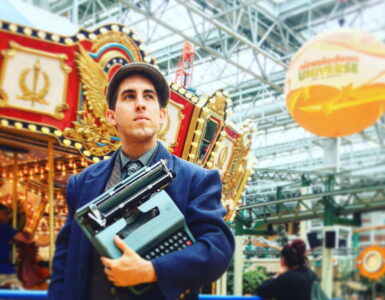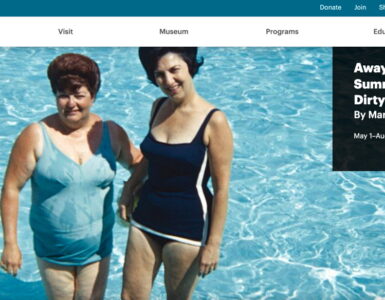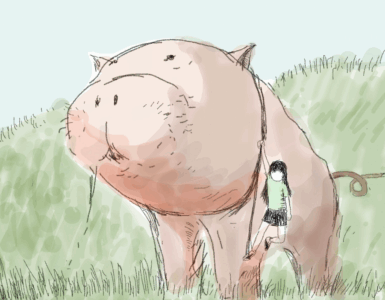
***
British watercolors are among the most striking examples of this luminous art form ever produced. The medium began to flourish in eighteenth-century England and was pursued by talented artists and amateurs. The art of watercolor painting was considered part of a genteel education. Due to portable materials, artists could also work outdoors, vividly capturing beautiful landscapes and architectural and historic sites. These specific geographical areas and buildings often resonated with a public eager to celebrate their country.
Report by Pauline Adamek
Watercolor remains one of the most challenging artistic techniques, capable of extraordinary luminosity but often resistant to control. Luminous Paper: British Watercolors and Drawings, on view July 19 – October 23, 2011 at the J. Paul Getty Museum at the Getty Center, presents more than twenty-five works of the 1700s and 1800s by some of the greatest masters of the medium, many on view for the first time.
Featuring the work of some of the most famous British artists, including J.M.W. Turner, William Blake and Samuel Palmer, this exhibition reveals their multifaceted innovations in the field of drawing and watercolor painting. From Turner”™s use of his thumbprint to roughen the texture of wash in a whirling seascape, to the reflected and re-reflected light built in layers by John Sell Cotman, the medium of watercolor was transformed beyond recognition. Other artists experimented with novel subject matter or new modes of representation, playing important roles in the development of European drawing and watercolor painting.
Key works have been added to the Getty”™s collection in the last few years as part of an ongoing initiative to build our holdings of British drawings and watercolors to better represent the wider European tradition, said Associate Curator Julian Brooks, who curated the exhibition. Many of these works have been recently acquired and were thrilled to be publicly displaying them for the first time in generations.

Among the recent acquisitions is Durham Cathedral and Castle (about 1800) by Thomas Girtin, a dramatic view of a medieval cathedral and castle set on a rocky outcrop above the water, amid the moving light of a bright, cloudy sky. Girtin died of tuberculosis at the age of 27, two years after making this drawing. His rival J.M.W. Turner is reputed to have said, “Had poor Tom lived, I would have starved.”
Another is View of the Church of Our Lady of Hanswijk, Mechelen (1831) by Thomas Shotter Boys, a central figure in Anglo-French artistic exchange of the period, and one of the most sophisticated practitioners of watercolor. He excelled in capturing effects of atmosphere and mood.
In the early 1700s watercolor painting was seen as an amateur pastime unworthy of true painters, but toward the end of the century British artists started to make watercolors designed to compete directly with oil paintings. They were bigger, with strong colors and dramatic compositions. The exhibition watercolor attracted new audiences of collectors and produced some of the most technically complex and powerful works in the medium.
To gather motifs and material for their exhibited works, British artists of the 1700s and 1800s often made sketching trips. Equipped with sketchbooks and portable boxes containing dry cakes of watercolor pigment and, later, moist versions and tubes, artists could easily capture the elements and effects of nature in color. Luminous Paper: British Watercolors and Drawings includes a sketchbook filled on a tour of northern England and Scotland by artist William Bell Scott and a paint box of the era, in addition to other books and letters from the collection of the Getty Research Institute.
Complementing Luminous Paper: British Watercolors and Drawings is a loan installation of three contemporary watercolors by British artist David Hockney, bringing the tradition of the exhibition watercolor into the present day. His colorful and personal landscapes of the Yorkshire countryside of his youth show his ceaseless experimentation with artistic technique and demonstrate that watercolor as a medium is alive and well in the 21st century.
A rich array of related events complements the exhibition, including talks by curator Julian Brooks, watercolor workshops and artist-at-work demonstrations, and Dark Blushing, an evening of poetry, music and art presented at the Getty in collaboration with the Write Now Poetry Society.

RELATED EVENTS
All events are free, unless otherwise noted.
Seating reservations are required.
For reservations and information, please call (310) 440-7300 or visit www.getty.edu.
LECTURE
Stories Stranger than Fiction, Pictures Larger than Life
Julian Brooks, associate curator of Drawings, the J. Paul Getty Museum, investigates some of the stories and characters behind British watercolor in the 1800s. Brooks focuses on artists who pushed the boundaries of watercolor and drawing, including J. M. W. Turner, Thomas Girtin, Edward Lear, D. G. Rossetti, and Aubrey Beardsley.
Sunday, July 31, 3:00 p.m.
Museum Lecture Hall, Getty Center
STUDIO COURSE
Watercolor Workshop
Join artist Richard Houston in this daylong workshop exploring the techniques and traditions of watercolor. Working in the studio and from the Getty”™s landscape, students explore watercolor materials, paint application, color mixing, light effects, and composition through a series of discussions and exercises.
Course fee $130 (includes materials). Open to 25 participants.
Wednesday, September 14th, 2011
10:30 a.m.””5:00 p.m.
Repeats October 5th, 2011.
Museum Studios, Getty Center
TALKS
Curators Gallery Talks
Julian Brooks, associate curator, Department of Drawings, the J. Paul Getty Museum, leads a gallery talk on the exhibition. Meet under the stairs in the Museum Entrance Hall.
Thursday, August 11, 1:30 p.m.
Wednesday, September 21, 1:30 p.m.
ARTIST-AT-WORK DEMONSTRATION
Artist-at-Work Demonstration: Watercolor
Drop by as artist Richard Houston demonstrates the materials and techniques used in watercolor painting with an emphasis on motifs and innovations developed by British artists in the 18th and 19th centuries.
Sundays, September 4th and October 2nd, 1:00″”3:00 p.m.
Museum Studios, Getty Center
PERFORMANCE
Saturday Nights at the Getty: Dark Blushing
Presented in collaboration with the Write Now Poetry Society, Dark Blushing is an evening of poetry, music, and art. Some of the brightest stars in contemporary poetry present new work inspired by the exhibition Luminous Paper: British Watercolors and Drawings. Their performances are interwoven with celebrity readings of the 18th- and 19th- century greats and lush live music.
Free, reservations required.
[Reservations available beginning Tuesday, August 23, 2011.]Saturday, September 10, 7:30 p.m.
Harold M. Williams Auditorium, Getty Center





